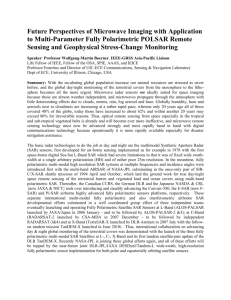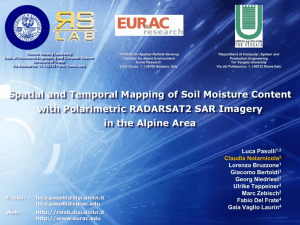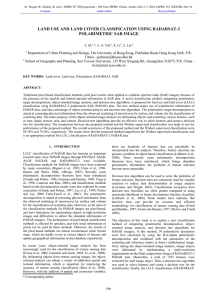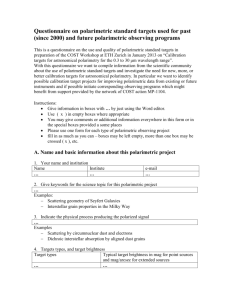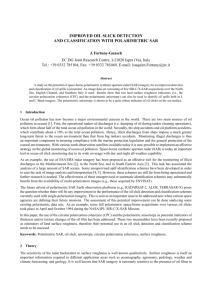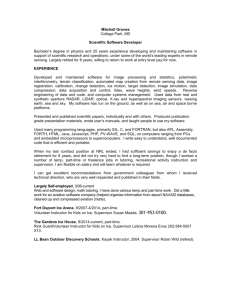POLARIMETRIC TWO-SCALE MODEL FOR THE RETRIEVAL
advertisement
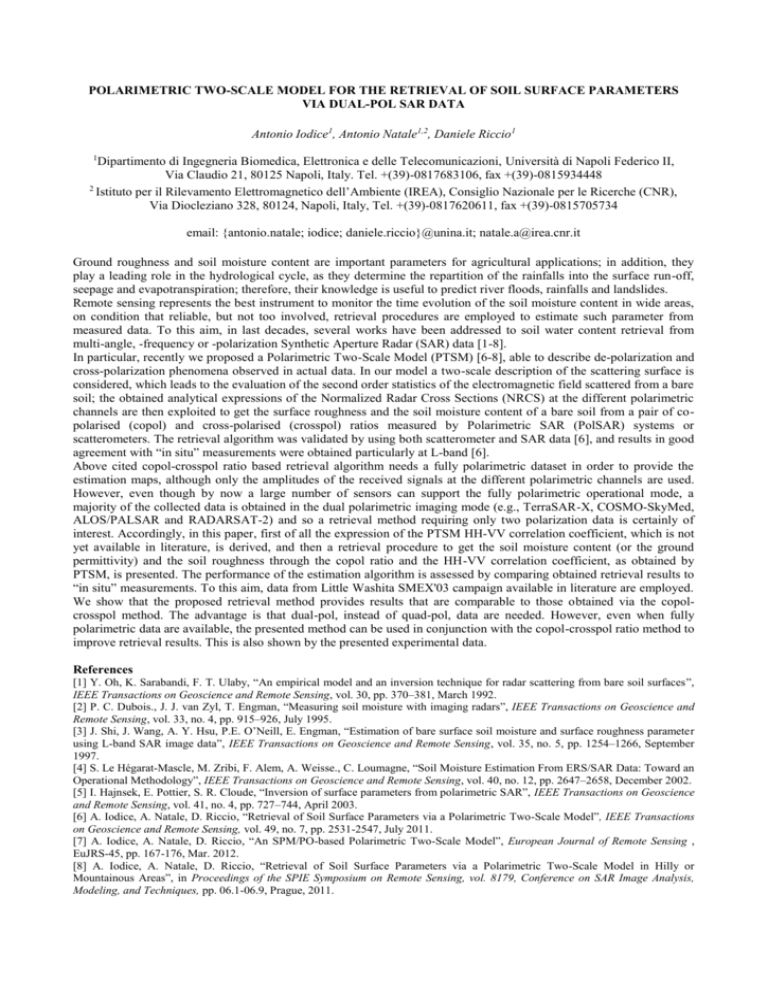
POLARIMETRIC TWO-SCALE MODEL FOR THE RETRIEVAL OF SOIL SURFACE PARAMETERS
VIA DUAL-POL SAR DATA
Antonio Iodice1, Antonio Natale1,2, Daniele Riccio1
1
Dipartimento di Ingegneria Biomedica, Elettronica e delle Telecomunicazioni, Università di Napoli Federico II,
Via Claudio 21, 80125 Napoli, Italy. Tel. +(39)-0817683106, fax +(39)-0815934448
2
Istituto per il Rilevamento Elettromagnetico dell’Ambiente (IREA), Consiglio Nazionale per le Ricerche (CNR),
Via Diocleziano 328, 80124, Napoli, Italy, Tel. +(39)-0817620611, fax +(39)-0815705734
email: {antonio.natale; iodice; daniele.riccio}@unina.it; natale.a@irea.cnr.it
Ground roughness and soil moisture content are important parameters for agricultural applications; in addition, they
play a leading role in the hydrological cycle, as they determine the repartition of the rainfalls into the surface run-off,
seepage and evapotranspiration; therefore, their knowledge is useful to predict river floods, rainfalls and landslides.
Remote sensing represents the best instrument to monitor the time evolution of the soil moisture content in wide areas,
on condition that reliable, but not too involved, retrieval procedures are employed to estimate such parameter from
measured data. To this aim, in last decades, several works have been addressed to soil water content retrieval from
multi-angle, -frequency or -polarization Synthetic Aperture Radar (SAR) data [1-8].
In particular, recently we proposed a Polarimetric Two-Scale Model (PTSM) [6-8], able to describe de-polarization and
cross-polarization phenomena observed in actual data. In our model a two-scale description of the scattering surface is
considered, which leads to the evaluation of the second order statistics of the electromagnetic field scattered from a bare
soil; the obtained analytical expressions of the Normalized Radar Cross Sections (NRCS) at the different polarimetric
channels are then exploited to get the surface roughness and the soil moisture content of a bare soil from a pair of copolarised (copol) and cross-polarised (crosspol) ratios measured by Polarimetric SAR (PolSAR) systems or
scatterometers. The retrieval algorithm was validated by using both scatterometer and SAR data [6], and results in good
agreement with “in situ” measurements were obtained particularly at L-band [6].
Above cited copol-crosspol ratio based retrieval algorithm needs a fully polarimetric dataset in order to provide the
estimation maps, although only the amplitudes of the received signals at the different polarimetric channels are used.
However, even though by now a large number of sensors can support the fully polarimetric operational mode, a
majority of the collected data is obtained in the dual polarimetric imaging mode (e.g., TerraSAR-X, COSMO-SkyMed,
ALOS/PALSAR and RADARSAT-2) and so a retrieval method requiring only two polarization data is certainly of
interest. Accordingly, in this paper, first of all the expression of the PTSM HH-VV correlation coefficient, which is not
yet available in literature, is derived, and then a retrieval procedure to get the soil moisture content (or the ground
permittivity) and the soil roughness through the copol ratio and the HH-VV correlation coefficient, as obtained by
PTSM, is presented. The performance of the estimation algorithm is assessed by comparing obtained retrieval results to
“in situ” measurements. To this aim, data from Little Washita SMEX'03 campaign available in literature are employed.
We show that the proposed retrieval method provides results that are comparable to those obtained via the copolcrosspol method. The advantage is that dual-pol, instead of quad-pol, data are needed. However, even when fully
polarimetric data are available, the presented method can be used in conjunction with the copol-crosspol ratio method to
improve retrieval results. This is also shown by the presented experimental data.
References
[1] Y. Oh, K. Sarabandi, F. T. Ulaby, “An empirical model and an inversion technique for radar scattering from bare soil surfaces”,
IEEE Transactions on Geoscience and Remote Sensing, vol. 30, pp. 370–381, March 1992.
[2] P. C. Dubois., J. J. van Zyl, T. Engman, “Measuring soil moisture with imaging radars”, IEEE Transactions on Geoscience and
Remote Sensing, vol. 33, no. 4, pp. 915–926, July 1995.
[3] J. Shi, J. Wang, A. Y. Hsu, P.E. O’Neill, E. Engman, “Estimation of bare surface soil moisture and surface roughness parameter
using L-band SAR image data”, IEEE Transactions on Geoscience and Remote Sensing, vol. 35, no. 5, pp. 1254–1266, September
1997.
[4] S. Le Hégarat-Mascle, M. Zribi, F. Alem, A. Weisse., C. Loumagne, “Soil Moisture Estimation From ERS/SAR Data: Toward an
Operational Methodology”, IEEE Transactions on Geoscience and Remote Sensing, vol. 40, no. 12, pp. 2647–2658, December 2002.
[5] I. Hajnsek, E. Pottier, S. R. Cloude, “Inversion of surface parameters from polarimetric SAR”, IEEE Transactions on Geoscience
and Remote Sensing, vol. 41, no. 4, pp. 727–744, April 2003.
[6] A. Iodice, A. Natale, D. Riccio, “Retrieval of Soil Surface Parameters via a Polarimetric Two-Scale Model”, IEEE Transactions
on Geoscience and Remote Sensing, vol. 49, no. 7, pp. 2531-2547, July 2011.
[7] A. Iodice, A. Natale, D. Riccio, “An SPM/PO-based Polarimetric Two-Scale Model”, European Journal of Remote Sensing ,
EuJRS-45, pp. 167-176, Mar. 2012.
[8] A. Iodice, A. Natale, D. Riccio, “Retrieval of Soil Surface Parameters via a Polarimetric Two-Scale Model in Hilly or
Mountainous Areas”, in Proceedings of the SPIE Symposium on Remote Sensing, vol. 8179, Conference on SAR Image Analysis,
Modeling, and Techniques, pp. 06.1-06.9, Prague, 2011.
